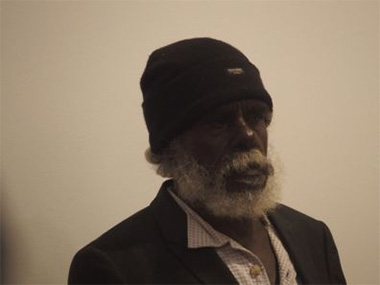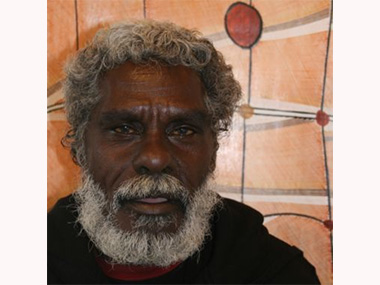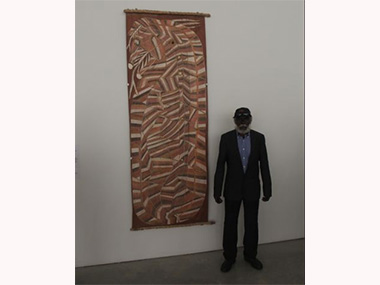MAWURNDJUL REFOUND

John Mawurndjul in Sydney at the MCA recently
Posted by Jeremy Eccles | 27.04.15
Gallery: Annandale Galleries
Dates:
14.04.15
: 23.05.15
We recently published the Chair of ANKAAA, Djambawa Marawili's cry from the heart about the essential importance of outstations to the maintenance of Aboriginal culture and art. Now, from over in Western Arnhemland, there's a story about the debilitating effects on a great artist's capacity to work arising from loss of access to his out-station.
John Mawurndjul has been a Kuninjku painting hero since his involvement in the famous French Magiciens de la Terre exhibition in Paris in 1989. Born in 1952, he was brought into the township of Maningrida in the 60s, but couldn't adapt to the European 'life-style' that was a key element of the assimilation processes of that era. Instead, he opted for the much harder life on an out-station called Mumeka where he could be largely self-sufficient – hunting, painting the land and its inter-connected Ancestors and spirits, and working up to being a ritual leader in ceremonies like the Mardayin and Kunabibi.
Thanks as well to a series of dedicated art centre co-ordinators such as Diane Moon and Apolline Kohen, Mawurndjul's art developed from the mainly figurative into a fascinating and widely successful 'abstract' take on bark images that could still be read in all their spirituality by initiates. In the wider world, though, they were seized on by the Musee du quai Branly in Paris, he was given a solo survey in Swiss and German museums, and he won the Clemenger Contemporary Art Prize in Melbourne. He was consequently able to maintain his outstation family life with three functioning off-road vehicles.
Jon Altman encountered John – whom he calls Balang, his skin name – in 1979 when researching the economics of this remote life, language and culture for his PhD. He admits in the catalogue accompanying Mawurndjul's current commercial show at Annandale Galleries – he's also to be seen now at TarraWarra in the Yarra Valley and the MCA in Sydney – that he was “blind-sided” by the results of the factors that have compounded since 2008 in his friend's life and artistic career.
Obviously there was the GFC – cutting sales from Indigenous art centres nationally by 50% between 2008 and '11. Then there was the cumulative effects of the Intervention – which replaced the historically competent management of Maningrida's Bawinanga Aboriginal Corporation, which owns the Art Centre, with people so inexperienced that it failed to operate efficiently while the art centre ran through a series of desperate co-ordinators. Meanwhile CDEP (the Community Development Employment Program) which gave art centre and out-station workers a basic income was “demonised and demolished” according to Altman. And a dispirited Balang, ceasing to have an art income ceased to paint, could no longer afford to access his outstation, moved into a Maningrida town camp and looked for a job as a tyre-repairer!
His income from this came with a demeaning Basics card telling this once proud and internationally recognised super-star what he could spend his money on.
Only his ceremonial life as the senior elder of the Kurulk estate and his value as an advisor to the Djelk Rangers on such matters as fire and resource management have sustained him, according to Professor Altman, in the absence, until now, of any supportive exhibitions by Australian art institutions. He, linguist Murray Garde and John Mawurndjul appeared in a forum at the Museum of Contemporary Art, which is belatedly doing its bit with three barks in its 'Luminous Show'. The private TarraWarra Museum of Contemporary Art is doing rather more with a serious showing of barks by both Balang and the late Gulumbu Yunupingu from eastern Arnhemland, curated by the now-freelance Hetti Perkins. It runs until 8th June.
In Sydney, the slight but still mentally strong Mawurndjul admitted that he'd “taken a break” from bark painting, and “it may be some time before I go back to it”. He is however, slowly returning to making and painting lorrkon, the 3D log coffins of the Kuninjku; also Mimi spirit sculptures. This is a man who is so deeply imbued with the ancient traditions of ceremony, use of ochres and rarrking that he could declare that leaving out just one of the four-colour palate of ochre colours – black, white, yellow and red – was a radical step. “But to be an artist, you have to do new things all the time”, he declared, “which is why I experimented with pure cross-hatching to reflect ideas with deeper meanings. As an artist, my body and knowledge changes – I think different things”.
“Besides”, he added, “I get nightmares if I paint Ngalyod (the female Rainbow Serpent who rises from her watery grave every wet season to check out the condition of the Country) all the time”.
Meanwhile, in Melbourne, Indigenous Art: Moving backwards into the future, has just opened at The Ian Potter Centre: NGV Australia. In the midst of some 'explanatory' wall signage that was as gobbledygook as the show's title, the caption accompanying one of John Mawurndjul's abstract barks informed me that the white band across the painting represented the sacred ochre that the artist collected from Dilebang. At the MCA, all the talk was of such a white band representing the creek that runs from Dilebang. But, in Balang's own words, it emerged that this personal supply of ochre - “the shit of Ngalyod” - lies in the banks of the river to be dug out with a crow bar by him – therefore reflecting the substance, the river and the Rainbow Serpent.
Practicality and spirituality coming marvellously together.
But when will Balang be able to get back to Dilebang's creek to replenish his supplies, and to his Milmilngkan outstation to refresh his culture?
See Annandale Galleries link under.
Share this:
»  del.icio.us
»
del.icio.us
»  Digg it
»
Digg it
»  reddit
»
reddit
»  Google
»
Google
»  StumbleUpon
»
StumbleUpon
»  Technorati
»
Technorati
»  Facebook
Facebook
Contact Details
Gallery: Annandale Galleries
Contact: Bill Gregory
Email: info@annandalegalleries.com.au
Telephone: +61 2 9552 1699
Address: 110 Trafalgar Street Annandale Annandale Sydney 2038 NSW
Gallery: Annandale Galleries
Contact: Bill Gregory
Email: info@annandalegalleries.com.au
Telephone: +61 2 9552 1699
Address: 110 Trafalgar Street Annandale Annandale Sydney 2038 NSW

The intensity of a man and his art at the height of his powers in 2007

The artist and his art at the Museum of Contemporary Art
Where is the exhibition?
Further Research
Gallery: Annandale Galleries
Artists: Gulumbu Yunupingu | John Mawurndjul
News Tags: Intervention | Jeremy Eccles | John Mawurndjul | Jon Altman | MCA | out-stations | TarraWarra Museum of Contemporary Art
News Categories: Australia | Blog | Exhibition | Feature | Industry | News
Exhibition Archive
- 10.10.17 | TARNANTHI 2017
- 11.08.17 | Natsiaas 2017
- 20.07.17 | APY ART DOMINATES THE WYNNE
- 17.07.17 | Anangu Artist Wins $100,000 Prize
- 14.07.17 | The End of AAMU
- 11.07.17 | ART ACROSS THE COUNTRY
- 11.07.17 | TARNANTHI IN OCTOBER
- 05.07.17 | TJUNGUṈUTJA - from having come together
- 13.06.17 | Ghost-Nets Straddle the World
- 07.06.17 | Grayson Perry Going Indigenous?
- 05.06.17 | Barks Bigger than Ben Hur
- 27.05.17 | NGA QUINQUENNIAL 2017
- 21.05.17 | Blak Douglas Finds Home at the NGA
- 21.05.17 | BRIAN ROBINSON WINS HAZELHURST WOP
- 18.05.17 | PARRTJIMA 2.0
Advertising

